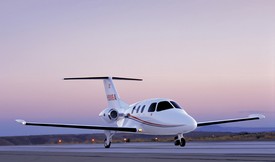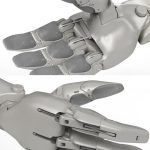The plane truth.
Another core component of the per seat on demand business plan is having an aircraft which is cheap, robust, flexible and efficient. It must also offer a travel option that customers want. And that’s where the Eclipse 500 aircraft should earn its wings.
“The travelling public don’t want to travel behind propellers, they want to travel in jet aircraft,” confirms Vern Rayburn, CEO of Eclipse Aviation, “We’ve designed a jet with operating costs less than half that of current equivalents, and which is a quarter of the price. It’s also a high utilization aircraft, a six seater [Boeing] 737. Reliable, and easy to fix.”
On the face of it the Eclipse 500 looks just like any other small corporate aircraft – sleek, shiny and expensive. Look closer though, and a number of interesting features begin to stand out. First off are the engines. The twin jets at the rear of the plane are almost toy sized, with an inlet diameter of just 14 inches. The interior also is significantly different. Gone is the closed off cockpit and exorbitant fittings of an executive jet, replaced by an elegant but simple interior that looks more like the inside of a luxury car than a jet aircraft.
The cockpit adds to the surprise, as it lacks traditional dials and gauges and instead is equipped with a bevy of colourful LCD screens and discrete soft switches. Actually the ‘newness’ of this bird is only partly to be found in the fixtures and fittings. The real revolution is buried deep inside the minutiae of manufacturing, design and operational management which powers the development and production of this new class of aircraft.
Fact 1. The Eclipse 500 is not made of trendy but expensive composite fibers as with some alternative VLJ designs, but instead relies on aluminium. The clever trick is that the craft is assembled using a sophisticated welding system called Friction Stir Welding, which reduces the number of seams and crucially does away with the heavy rivets used in traditional aircraft design. Result, a huge weight saving, whilst retaining structural strength and resilience. The 263 welds on the plane replace 7,378 conventional fasteners.
Fact 2. The avionics, from Avidyne, are based on state of the art, software configurable plug-in control panels. The aircraft’s instrumentation can be maintained and upgraded with simple plugin modules which add more functionality as needed. Result, a massive cost saving, meaning in some cases 10 times less on expenditure for cockpit systems.
Fact 3. State of the art Pratt & Whitney Canada engines offer 900 lbs of thrust from an industry leading size and weight configuration. Result, better payload capabilities and range than comparable aircraft of the same size and weight. Result, running costs should be somewhere in the order of $0.69c per mile (at year 2000 values). The aircraft is designed to fly at a height of 20–25,000 feet at 375 knots. Most of the short run, on-demand journeys are likely to be a maximum of 300 to 600 miles in distance.
Fact 4. Design and manufacture. The secret of the sauce is often in the hidden ingredients and so it is with the Eclipse 500. The plane is a complete digital design, no metal models or prototyping. All of the documentation and even the factory layout (down to the placement of stair handrails) is done digitally. Result, unprecedented speed of design, test and prototyping. The company currently holds three design reviews a week, and is on track to meet an eventual, and astonishing, production target of six planes a day.
Fact 5. The backend operational systems are state of the art SAP Netweaver powered. This is a small company which has implemented enough computing power to ensure scalable production into the big league.
Fact 6. The above technological focus has resulted in an aircraft that matches the performance specifications of craft 2 or 3 times its cost. The current price of an Eclipse 500 is set at around $1.3 million, which is unprecedented for a jet aircraft of this specification.
“We have 2200 orders on the books and will start delivery of our first aircraft by March of next year,” says Rayburn, “The whole Dayjet philosophy is a really nice mesh with that of Eclipse. You make sure you set rational price points for this kind of transport, and charge exactly what it’s worth.”
Continue Reading… 1 2 3 4 5 [View All]





Wow Red, this is exciting, and much more than I expect from a blog. Not to denigrate the Journal, but is this running elsewhere? It seems to deserve more mainstream coverage.
Sounds like flying may be fun again. Soon. Coincidentally I just moved to New Mexico…
Heh, thanks Andi. No I haven’t placed it anywhere else yet, and I agree that I think it could be very interesting in the long run and so deserves more attention. Let’s see, maybe some cute Ferrety reader will pick it up….
I’ll be fascinated to see how the project goes, and hope to have another chat with Ed when he next comes over to Europe. :)